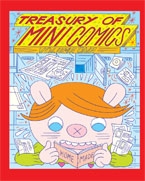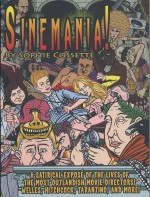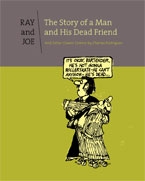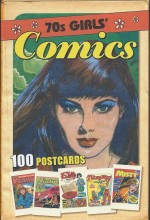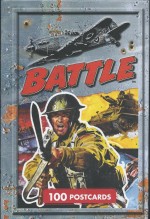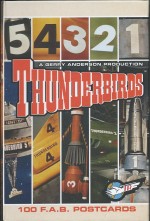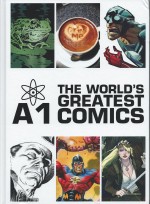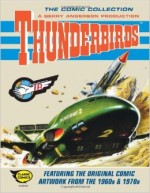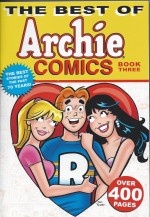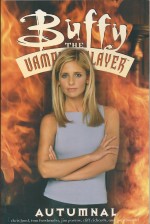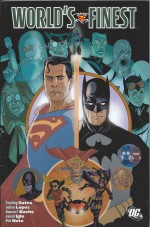
By Sterling Gates, Julian Lopez, Ramon F. Bachs, Jamal Igle, Phil Noto & various (DC Comics)
ISBN: 978-1-4012-2797-5
For decades the Man of Tomorrow and Caped Crusader were quintessential superhero partners: the “World’s Finest teamâ€. The affable champions were best buddies as well as mutually respectful colleagues and their pairing made sound financial sense since DC’s top heroes could happily cross-pollinate and cross-sell their combined readerships.
During the 1950s most superheroes of the American Golden Age faded away leaving only headliners Superman, Batman and Wonder Woman (plus whoever they could carry in the back of their assorted titles) to carry on a rather genteel campaign against a variety of thugs, monsters and aliens.
With economics and rising costs also dictating a reduction in average page counts, the once-sumptuous anthology World’s Finest Comics (originally 96 pages per issue), which had featured solo adventures of DC’s flagship heroes plus a wealth of other features, simply combined the twin stars into a single lead story every issue, beginning with #71, July-August 1954.
And so they proceeded until 1970 when another drop in superhero fortunes saw WFC become a Superman team-up book with rotating guest partners. However, after a couple of years, the original relationship was rekindled and renewed and, with the World’s Finest Heroes fully restored to their bizarrely apt pre-eminence, enjoyed another lengthy run until the title was cancelled during Crisis on Infinite Earths in 1985-1986.
The maxi-series rewrote the DC universe, and everything was further shaken up by John Byrne’s subsequent retooling The Man of Steel which re-examined all the Caped Kryptonian’s close relationships in a darker, more cynical light.
When the characters were redefined for the post-Crisis era, they were recast as suspiciously respectful co-workers who did the same job but deplored each other’s methods and preferred to avoid contact whenever possible – except when they were in the Justice League of America (but for the sake of your sanity, don’t fret that right now!).
Over the following few years of this new status quo the irresistible lure of Cape & Cowl Capers inexorably brought them together again, but now with added modern emotional intensity derived from their incontestable differences.
Moreover, sentimental fools that we comics fans are, the sheer emotional cachet (and perhaps copyright value of the brand) ensured that every so often a new iteration of the singular title was released to keep all interested parties happy…
Thus this moody, cleverly post-modern 21st century spin on the irresistible combination of heroic dynasties which gathers World’s Finest volume 4, #1-4 from December 2009-March 2010, set during the period of the recent overarching Superman publishing event “World of New Krypton/World Without Supermanâ€, wherein 100,000 Kryptonians who have escaped imprisonment in the Bottle City of Kandor gain superpowers under Sol’s light, and build themselves a planet in our solar system…
The book also contains supplementary material from Action Comics #865, 2008 and DC Comics Presents #31, 1981.
With the Man of Steel’s arch-nemesis General Zod prominent and pre-eminent in the newly re-established society of New Krypton, and most of Earth crazy-paranoid about a world full of belligerent supermen flying around in their backyard, Kal-El has abandoned his adopted homeworld to keep an eye on the system’s newest immigrants…
Earth is not completely defenceless, however. As well as the JLA and Superman’s hand-picked replacement Mon-El of Daxam, Supergirl and a mysterious “Superwoman†still fly the skies and top-secret, sinister paramilitary, anti-alien task force Project 7734 is watching, certain that there are other ET insurgents just waiting in hiding…
Against such a backdrop this quartet of interlinked team-ups written by Sterling Gates charts a heroic procession which begins with ‘Nightwing and Red Robin’ (illustrated by Julian Lopez and Bit) and finds the latest Kryptonian to use the appellative seek out the third Boy Wonder’s aid in rescuing his partner Flamebird from the insidious criminal broker The Penguin…
In Case You Weren’t Paying Attention: “The Dynamic Duo of Kandor†were first created by pulp author Edmond Hamilton with artists Curt Swan & George Klein for Superman #158 (January 1963, ‘Superman in Kandor!’) which saw raiders from the Kryptonian enclave attacking the Man of Steel and painting him as a traitor to his people.
The baffled Superman then infiltrated the BottleCity with Jimmy Olsen where they created Batman and Robin-inspired masked identities Nightwing and Flamebird to ferret out an answer.
Over intervening decades the roles were reprised by a number of others in Kandor and on Earth, before eventually being appropriated for Bat-characters when Dick Grayson became Nightwing and original Batgirl Bette Kane re-branded herself as Flamebird.
The latest heroes to use the names are Kryptonians masquerading as human heroes during this time of xenophobic hysteria: failed soldier and former priest Thara Ak-Var and Lor-Zod, a boy born in the Phantom Zone and briefly adopted by Lois and Clark Kent (for further details check out Superman: Nightwing and Flamebird volume 1).
With Thara captive, the former Christopher Kent has tracked down Tim Drake, whom he had previously met. They unite to rescue Flamebird, consequently uncovering an insidious, wide-ranging plan involving many members of their respective crime-busting clans as well as villains Kryptonite Man and the robotic Toyman…
With mission accomplished the heroes are replaced in #2 by ‘Guardian and Robin’ (art by Ramon F. Bachs & Rodney Ramos) as the clone of 1940s mystery man Jim Harper tries to fill the Man of Steel’s shoes in Metropolis, battling human Xerox machine Riot, only to run into the latest iteration of Robin (Damien Wayne, son of Bruce and Talia Al Ghul).
The acerbic, abrasive, assassin-trained 10-year old is tracking stolen Waynetech gear and won’t let super creeps like Mr. Freeze or the life-leeching Parasite stand in his way – even if it means having to work with sanctimonious old fogeys like the Golden Guardian. Sadly neither generation of hero is aware that Toyman will intercept their prisoners as soon as they hand them over to the cops…
In another part of Metropolis, cyber-crusader Oracle contacts the undercover Girl of Steel for a mission. The enigmatic data-wrangler has tracked Freeze and Kryptonite Man to Gotham but her usual operatives have been captured by the mystery mastermind behind the plot. Flying to the rescue, Kara Zor-El effects their rescue but chooses not to work with the morally-ambiguous Catwoman. She has no problems pairing with the junior partner, however…
‘Supergirl & Batgirl’ (illustrated by Jamal Igle, Jon Sibal & Jack Purcell) finds the Kryptonian bonding with Stephanie Brown (daughter of C-list bad-guy Cluemaster, and previously known as The Spoiler and fourth Robin) tracking the nefarious trio of nogoodniks and uncovering the truth behind the far-reaching plot.
The original aged paranoid inventor Toyman wants to remove forever the threat of the aliens above him. To that end he has constructed a monolithic Superman/Batman Robot, stuffed it with lethal Green -K ordinance (courtesy of reluctant hostage Kryptonite Man) and sent it hurtling towards New Krypton.
At least he would have if those interfering kids hadn’t become involved and set the monstrous K-droid rampaging through downtown GothamCity…
Everything pulls together for the climactic ‘Superman & Batman’ – with art from Phil Noto – as replacement Dark Knight Dick Grayson convinces the original Man of tomorrow to temporarily abandon his clandestine assignment on New Krypton to join him in stopping the rioting robot.
The new Daring Duo are as much hampered as assisted by Robin and Batgirl, and things go from bad to worse when the manic mechanoid finally launches for space with Supergirl and Batman still aboard…
Despite a lot of potentially confusing backstory to navigate, this is a tremendously engaging Fights ‘n’ Tights romp, packed with rollercoaster pace and drenched with light-hearted action: even finding room for a portentous teaser of more sinister games in play. As such it should amply reward fans of either or both franchises, but this tome also includes even more comics thrills, chills and spills.
It starts with an introduction from Sterling Gates dealing with how star scribe Geoff Johns married a myriad different and conflicting versions of one of Superman’s oldest foes into a viable and thoroughly competent revival, revealing the life-secrets and horrific motivations of ‘The Terrible Toyman’ (Action Comics #865, July 2008, illustrated by Jesus Merino) to doomed hostage Jimmy Olsen and, of course, us…
Dick Grayson also gets a another shot sharing the limelight with the Man of Steel as ‘The Deadliest Show on Earth’ (by Gerry Conway, José Luis GarcÃa-López & Dick Giordano from DC Comics Presents #31, March 1981) concisely describes the odd couple’s pre-Crisis battle against a psychic vampire predating the performers at the troubled Sterling Circus…
With covers and variants by Noto, Kevin Maguire, Brad Anderson, Ross Andru & Giordano, this is a surprisingly satisfying superhero treat for all fans of Costumed Dramas and raucous rowdy adventure.
© 1981, 2008, 2009, 2010 DC Comics. All Rights Reserved.

